Gaited horses have always sparked curiosity among mainstream equestrians. We all have our preconceived notions about these special horse breeds, but what exactly is a gaited horse?
A gaited horse is one that can perform one or more gaits other than walk, trot, canter, and gallop. Most gaited horse breeds always have one foot on the ground, which conserves the horse’s energy and makes the rider smoother.
Gaited horses were most popular when horses were the primary mode of transportation. Because of their smooth gaits, people could travel long distances without being sore at the end of the day.
A study in 2012 revealed that a dominant gene called DMRT3 is responsible for the ambling gaits of gaited horses. This gene controls circuits of neurons along the spinal cord that directly link to limb movement. In 2014, researchers uncovered that this gene initially appeared in a single ancestor of all gaited horse breeds.
Here are some interesting facts and FAQs about gaited horse breeds!
How Can You Tell if a Horse Is Gaited?
Identifying a gaited horse isn’t easy at first glance as some unique gaits are less obvious than others. Before you are able to tell them apart, you first need to understand how these gaits differ from traditional ones.
To tell if a horse is gaited, you need to look at the horse’s footfall. Most gaited horses perform ambling gaits, which is when they move each foot individually in a specific manner. This creates a distinct gliding motion and causes the rider to sit still in the saddle.
The exception to this rule is pace, a lateral two-beat gait where the horse simultaneously moves its legs on the same side. You will also notice that pacers sway their heads and necks side to side as they move their legs forward.
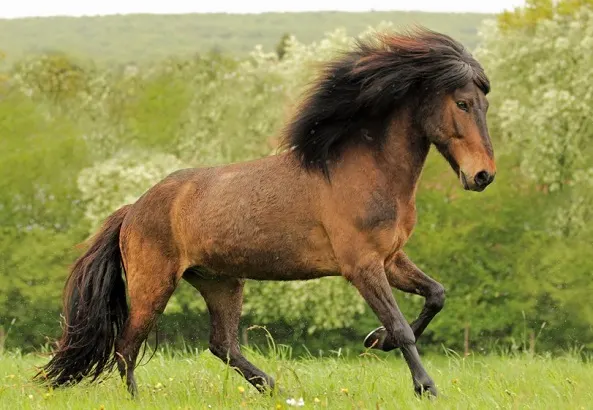
Alexandra Hollstein / Shuttertsock.com
On the other hand, ambling gaits are four-beat, meaning the horse will always have one foot on the ground. As this eliminates the moment of suspension that happens during trot and pace, ambling gaits are much smoother and comfortable to ride.
What Is the Purpose of Gaited Horses?
The purpose of gaited horses is to carry riders comfortably over long distances. These horses could travel all day without growing tired because they exert less energy through their special gaits.
Gaited horses were once very popular in Europe, as they provided a comfortable way of travel on poor roads. However, their popularity declined when road conditions improved, and carriage travel became more prevalent.
On the American continent where distances are much greater, gaited horses remained popular for longer. They became an essential asset to life on the plantations, where farmers often went for day-long rides to inspect the crops.
Eventually, trotting horses prevailed over gaited breeds in all parts of the world. These horses could gallop faster and jump higher, making them a popular choice for sports and entertainment.
Due to mechanization and the emergence of equestrian sports in the 20th century, gaited horses fell out of favor.
Luckily, gaited horses still have a place in the modern world. Besides being beautiful and unique, they are famous for having great stamina and an easy-going temperament. Hence why trail riders and beginners around the world choose to have gaited horses.
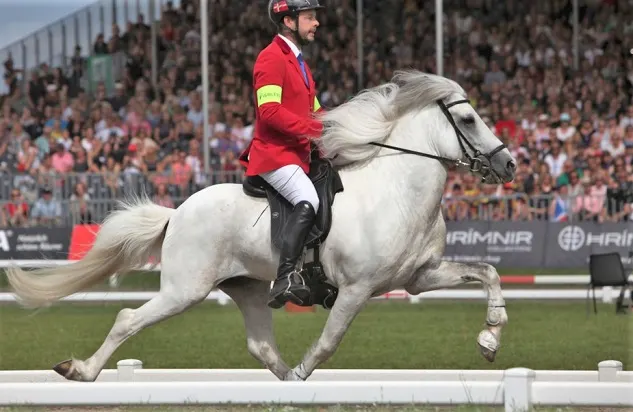
klauscook / Shutterstock.com Special Horse Gaits Explained
As mentioned before, special horse gaits fall into two categories: ambling and two-beat. Generally, ambling gaits are faster than a walk but slower than a canter or a gallop. In comparison, the only special two-beat gait (pace) has a medium speed similar to that of a trot.
While several horse breeds replace walk and trot with a special gait, almost all gaited horses can gallop! Retaining this ability is essential for survival if the horse needs to get away from a predator in the wild.
Below, we compiled a list of the most common special horse gaits:
Lateral Ambling Gaits
There are two main types of ambling gaits: lateral and diagonal. Horses performing lateral ambling gaits look like they are moving their legs on the same side together, although the hind foot will always land slights before the front. These gaits follow the same footfall pattern as the walk, which is right hind, right front, left hind, left front.
Slow Gaits
Slow gaits include a few different types of ambling gaits, such as the singlefoot and stepping pace. These low-speed gaits are especially smooth and comfortable for the rider.
While certain slow gaits come naturally to some horses, others develop gradually from the pace.
Running Walk
The running walk is mostly associated with the Tennessee Walking Horse breed. Similar to other ambling gaits, it follows the footfall of the traditional walk. However, while a horse can only walk at 4 to 8 mph (6.4 to 12.9 km/h), a running walk can reach 10 to 20 mph (16 to 32 km/h).
During this gait, the horse’s hind feet overstep the hoofprints of the front feet by about 6 to 18 inches (15 to 46 cm). A longer overstep is highly desirable in the Tennessee Walking Horse breed. In running walk, the horse also nods its head in synchrony with the rhythm and speed of the gait. (Source: Wikipedia)
Rack
Rack is another lateral four-beat gait that’s characteristic of the American Saddlebred and the Racking Horse. It’s essentially a sped-up slow gait where the horse maintains even intervals between each footfall. This produces an intermediate gait that’s much smoother than the trot and gives the rider the feeling of the “horse climbing a ladder.”
For a horse to perform the rack, it must take up a hollow posture. The horse’s neck is elevated in this position, and its hind legs trail out beyond the horse’s frame. This is the opposite of the rounded posture we see in most riding horses, where the head is lowered, and the hindlegs step further underneath the body.
A hollow posture allows gaited horses to maintain the rack without transitioning into another gait. However, a hollow back is not ideal for carrying a rider’s weight, and it will likely cause the horse to strain while ridden.
Paso Gaits
The Paso gaits are unique to the Paso Fino and Peruvian Paso horse breeds. The Paso Fino performs three distinct gaits that all have an even 1-2-3-4 rhythm but differ in speed. These are the Paso Fino, the Paso Corto, and the Paso Largo.
Paso fino is Spanish for smooth/fine step, and it’s the slowest of the three gaits. It is mainly performed in competitions and horse shows. The Paso Corto is a moderate-speed gait, while the Paso largo is the breed’s fastest speed, and it’s similar to the rack.
The Peruvian Paso’s special gaits are the Paso Llano and the Sobreandando. The Paso llano is an even gait that follows the same sequence as the running walk and features an elongated lateral shoulder movement.
In contrast, the Sobreandando has a faster but slightly uneven gait that resembles the stepping pace.
Tölt
The tölt is a lateral ambling gait that’s characteristic of Icelandic Horses. It follows the same footfall pattern as the walk, but the front legs come up higher.
This special gait is famous for its varying speeds and ground-covering motion. Icelandic Horses can increase the speed of the tölt up to the speed of a traditional canter without causing the rider to bounce in the saddle.
Diagonal Ambling Gaits
Unlike lateral four-beat gaits, diagonal ambling gaits are slightly uneven and derive from trot rather than pace. The horse’s legs follow a 1-2, 3-4 rhythm, which gives the rider a minor sensation of swinging forward and backward.
Since diagonal ambling gaits don’t require a hollow posture, they are easier for the horse. Interestingly, the gene responsible for this motion is apparently the same gene present in horses with lateral ambling gaits. (Source: Wikipedia)
Foxtrot
The foxtrot is a diagonal four-beat gait where the front feet of the diagonal pair touch down slightly before the hind feet. As one foot is always weight-bearing, the foxtrot is much smoother than the traditional trot.
This special gait gives viewers the impression that the horse is walking with its front feet and trotting with its hind feet. The foxtrot is the intermediate gait of the Missouri Fox Trotter horse, which is famous for being very sure-footed. It is also one of the few ambling gaits non-gaited horses can learn to perform.
Other diagonal ambling gaits include:
Marcha batidaTrochaPasitrote Two-Beat Gaits Pace
Pace is the only two-beat gait among gaited horses. Pacers move their parallel pairs of legs together, and there is a moment of suspension between the two beats. While pacing gives a smoother sensation than a trot, it’s not as smooth as other special gaits.
Several horse breeds can perform the pace, including the Icelandic Horse and American Standardbred. There are two different types of pace: straight pace and flying pace. While straight pace is a medium-speed gait, flying pace can reach speeds of 30 mph.
Can Any Horse Be Gaited?
In theory, any horse can learn to be gaited. Non-gaited horses can be taught some special gaits, but not every horse will pick it up easily.
The gaited trait is caused by a mutation in the DMRT3 gene, which can occur in virtually any horse breed. Hence the reason why non-gaited breeds can have a few individuals that are born gaited.

Mark Green / Shutterstock.com
The Morgan and Appaloosa breeds are known to have a few bloodlines that produce foals with special gaits.
Which Gaited Horse Is the Smoothest?
Many believe the Paso Fino horse has the smoothest gaits. However, this is also a matter of personal preference, and opinions might differ between equestrians.
Generally, all four-beat ambling gaits produce a smooth ride, and the differences between each are minuscule. Low-speed gaits tend to be smoother than high-speed ones as faster motion creates more vibrations.
8 Common Gaited Horse Breeds
Out of the 600+ horse breeds that exist today, only around 30 are gaited. However, things are not always black and white. Not all horses from gaited breeds display special gaits, and some horses with trotting ancestors may have ambling gaits.
Overall, gaited horse breeds are sturdy, sure-footed, and don’t require much input from the rider. They most commonly occur in North and South America but are also present in other parts of the world.
Gaited horse breeds often have a higher set head and neck and may have up to five gaits.
1. American Saddlebred
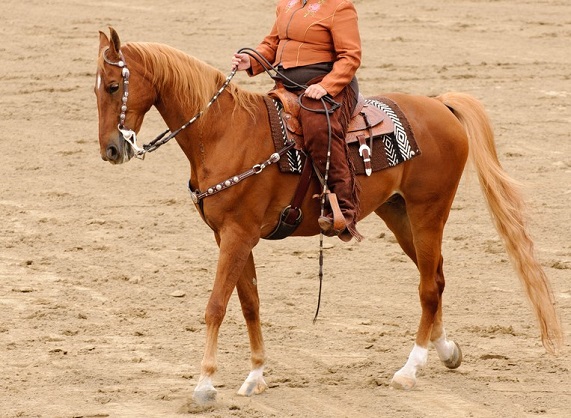
Jeffrey B. Banke / Shutterstock.com
The American Saddlebred is one of the most popular gaited horse breeds in the United States. It originated in the 18th century and was later dubbed “The Horse America Made.”
The Saddlebred is a five-gait breed able to perform a slow gait and a rack in addition to traditional gaits. Their flashy movement makes these horses a popular choice for parades and saddle seat competitions.
The breed is characterized by a high neck and tail carriage, with an average height of 15-17 hands. Due to its versatility and athleticism, the American Saddlebred performs well in many equestrian disciplines.
2. American Standardbred

Eric Buermeyer / Shutterstock.com
The American Standardbred is a popular harness racing breed in the United States. Two types of Standardbreds exist: pacers and trotters. Although many Standardbreds can both trot and pace, they usually specialize in one type of harness racing.
Pacers tend to outperform trotters in terms of speed, averaging around 35 mph (56.5 km/h) on the track versus the 30 mph (48.5 km/h) average of trotters. While harness racing is the Standardbred’s original purpose, they also make great pleasure riding and competition horses.
Typical height in the breed ranges from 14 to 17 hands. Interestingly, Standardbreds that prefer pacing to trotting may find it difficult to maintain canter and often need the help of a specialized gaited trainer.
3. Icelandic Horse

klauscook / Shutterstock.com
Another naturally pacing breed is the Icelandic Horse. These horses actually have five gaits, including the four-beat ambling tölt. This special gait enables Icelandic Horses to carry their riders safely over rough terrain.
The Icelandic Horse is one of the oldest horse breeds still in existence today. They are small horses that average 12 to 14 hands at the withers, but are fully capable of carrying an adult.
Icelandic Horses are primarily used for trail riding and showing, but are suitable for many equestrian disciplines.
4. Missouri Fox Trotter

rokopix / Shutterstock.com
The Missouri Fox Trotter breed is famous for its smooth diagonal ambling gait, the foxtrot. Riders can travel long distances without becoming sore and pass safely over uneven grounds in this special gait.
The Missouri Fox Trotter is extremely sure-footed, gentle, and versatile. Although they were initially developed for ranching, they are suitable for a range of equestrian purposes.
Missouri Fox Trotters are on average 14 to 16 hands tall and come in a variety of colors.
5. Paso Fino
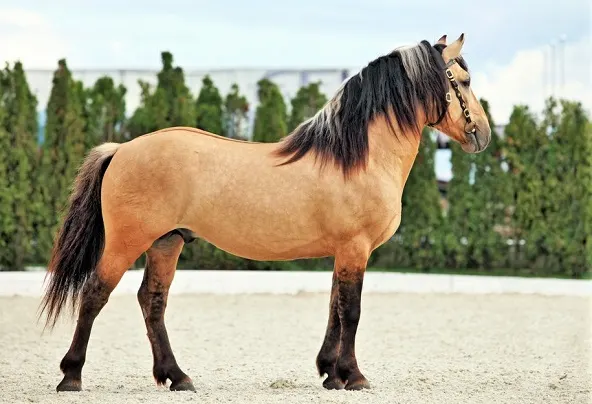
horsemen / Shutterstock.com
The Paso Fino is a popular gaited horse breed that originates in the Caribbean region. They are small but sturdy horses with three ambling gaits, namely the Paso Fino, Paso Corto, and Paso Largo.
The Paso Gino gait is slower than a walk because of its short stride length. In contrast, the Paso Corto is nearly as fast as a trot, and the Paso Largo is approximately the speed of a canter.
Both the Paso Fino and Peruvian Paso breeds inherited their special gaits from the now-extinct Spanish Jennet. The Paso Fino resembles its Spanish ancestors closely with its baroque appearance and almond-shaped eyes. The breed’s temperament is often described as “energetic but always obedient.”
6. Peruvian Paso
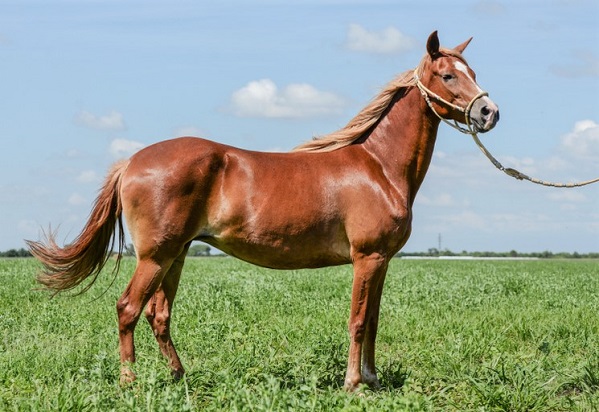
mifotodigital.club / Shutterstock.com
Considered the pride of Peru, the Peruvian Paso has been declared Cultural Heritage of the Nation by the Peruvian National Institute of Culture. This elegant breed has two special gaits, the slower Paso Llano, and the faster Sobreandando.
The Peruvian Paso is similar to the Paso Fino, but has a heavier body type. The Peruvian Paso is typically 14 to 15 hands tall and used for trail, pleasure, and endurance riding purposes.
7. Tennessee Walking Horse

aleigha blakley / Shutterstock.com
The Tennessee Walking Horse is among the most popular horse breeds in the United States. It’s mainly renowned for its smooth running walk that historically enabled Southern farmers to inspect their plantations all day long.
Besides the running walk, Tennessee Walking Horses may also perform the rack, foxtrot, stepping pace, and singlefoot. However, these gaits are undesirable in the show ring.
Prized for its extravagant movement, the Tennessee Walking Horse can be 14 to 17 hands tall and has an easy-going temperament.
8. Walkaloosa

The term “Walkaloosa” refers to any gaited horse that has an Appaloosa spotting pattern. For example, you can produce a Walkaloosa by crossing an Appaloosa with a Paso Fino or a Tennesse Walking Horse.
The Walkaloosa Horse Association was originally founded to preserve a special strain of Appaloosa horses that are naturally gaited. These horses exhibit a four-beat ambling gait known as the Indian Shuffle.
Appaloosas born with this gait are automatically eligible for Walkaloosa registration.
The Indian Shuffle is an exceptionally smooth, ground-covering gait of medium speed. Gaited Appaloosas were highly prized by the Nez Perce people who first created the breed. Many believe shuffling Appaloosas inherited their special trait from Paso Fino ancestors.
Other gaited horse breeds include:
Kentucky Mountain Saddle HorseFlorida Cracker HorseRocky Mountain HorseMarwariMorganAppaloosaRacking Horse
Source: horseyhooves.com








